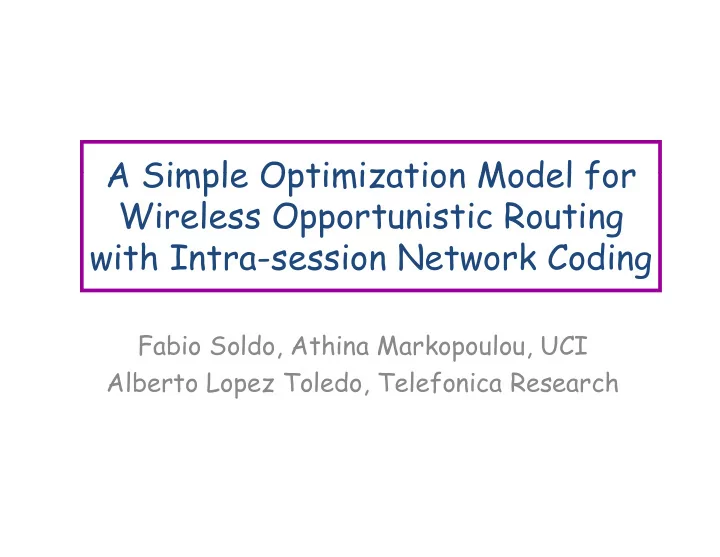

A Simple Optimization Model for A Simple Optimization Model for Wireless Opportunistic Routing with Intra-session Network Coding h k d Fabio Soldo, Athina Markopoulou, UCI Alberto Lopez Toledo Telefonica Research Alberto Lopez Toledo, Telefonica Research
Outline Outline • Scenario • Opportunistic Routing and Intra-session NC • Optimization Model – Multiple sources, lossless links – Multiple sources, lossy links • Decomposition and Interpretation • Conclusion
Wireless Mesh Networks Wireless Mesh Networks • Focus on WMNs: – Multiple paths – Braodcast channel – Spatial reuse – Lossy links L li k – MAC contention and interference interference
Opportunistic Routing Opportunistic Routing • Opportunistic Routing vs. Predetermined Routing pp g g – Next-hop node not chosen a priori – At each transmission a set of candidate nodes is selected l d – After packet transmission, candidate nodes (implicitly) coordinate to elect a forwarder (implicitly) coordinate to elect a forwarder C .9 .9 .1 A B .9 .5 D Biswas, Morris, “Opportunistic Routing in Multi-Hop Wireless Networks”, SIGCOMM 2005
Opportunistic Routing and NC Opportunistic Routing and NC • OR requires: signaling + coordinating OR requires: signaling coordinating candidate nodes • Use intra-session NC to simplify the mp fy scheduling .9 .9 9 .1 .9 .5 Chachulski et al, “Trading Structure for Randomness in Wireless Opportunistic Routing”, SIGCOMM 2007
Opportunistic Routing and NC Opportunistic Routing and NC • OR+NC: new questions OR NC: new questions – When should each forwarder stop sending packets? – How about the source ? • OR+NC: optimization models p – [Radunovic et al. 2009] propose a primal-dual algorithm • Use hyper-graph h h • Requires introducing credit variables to separate flow control and routing variables g • Use Lyapunov function to prove stability
Optimization Model Optimization Model Goal: • Use node-specific variables to understand Use node specific variables to understand the interaction OR+NC with – Multiple sources, lossless links p , – Multiple sources, lossy links
Notation Notation • Model WMN as Graph: Model WMN as Graph: – |V|=N nodes, |E| edges – C, link capacity p y – K source-destination nodes: : # of pkts of flow k # f kt f fl k – sent by node i – : # pkts of flow – k received by node i from “ “upstream” nodes ” d
Optimization Model M lti l Multiple sources, lossless links l l li k
Decomposition L Lossless links l li k • Consider the (partial) dual: Consider the (partial) dual: • Where:
Decomposition Lossless links L l li k • D1: D1 C Congestion ti Control • D2: D Routing • D3 Wireless Wireless Interference
Decomposition L Lossless links l li k • D1: D1 C Congestion ti Control • Admits a unique solution:
Decomposition Lossless links L l li k • D2: D2 Routing i j j j j Feedback provided by Feedback provided by j j 2 3 the union of 1 downstream nodes
Solving the Dual Problem Solving the Dual Problem • Dual problem: • Dual problem: f can be solved using a sub- gradient method: gradient method: g2 g2 g1 • Guaranteed to converge G t d t (provided the primal problem is convex) convex)
Solving Dual Problem Solving Dual Problem • Primal problem: Primal problem: • Update rule: U d t l
Solving Dual Problem Solving Dual Problem • Source rate decreases: Source rate decreases: • Destination’s neighbors increase their rate • This propagates backward to all active nodes Thi b k d ll i d
Optimization Model M lti l Multiple sources, lossy case l • Notation: : loss probability between i and j loss probability between i and j – : : (avg) number of packets – received by any of i’s neighbors
Optimization Model M lti l Multiple sources, lossy links l li k
Optimization Model D Dual Problem l P bl
Conclusion Conclusion • Present a simple model for OR+NC using node- • Present a simple model for OR+NC using node- specific variables: – we do not need to model predetermined routes. we do not need to model predetermined routes. • It allows to derive how: – E2E: the source rate adapts to end-to-end p feedback – H2H: each intermediate node coordinates with the union of its downstream neighbors i f its d st m i hb s • Future work: – Further analysis on OR+NC interactions Further analysis on OR+NC interactions – Protocol design
Thank you! y
Recommend
More recommend